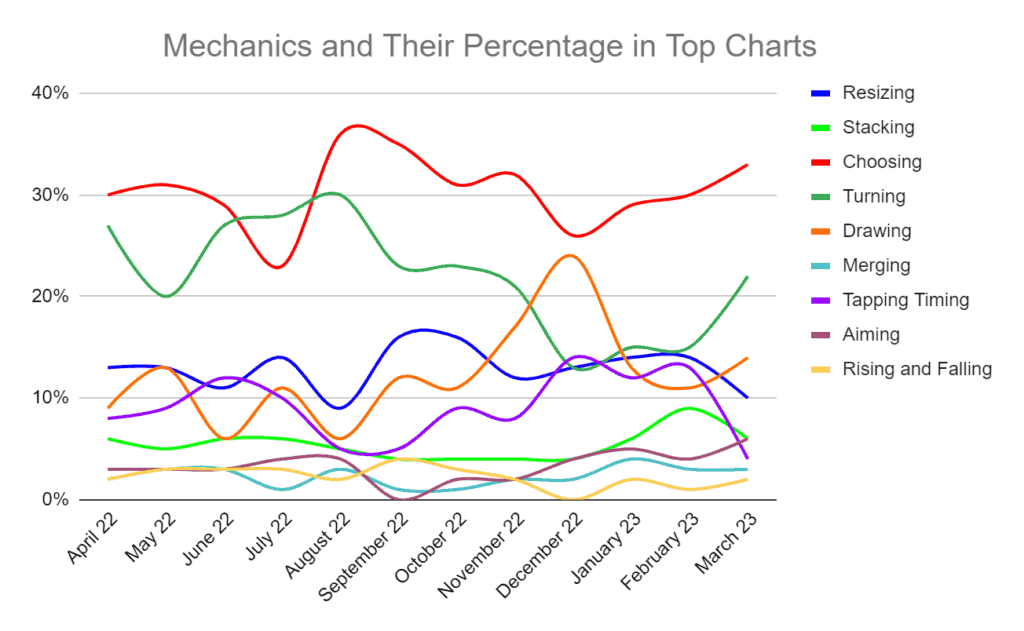The winning formula behind a successful hyper-casual and hybrid game is easy-to-understand, short, and simple game mechanics. Mechanics are the foundation of a game’s design, so you must be very strategic when selecting the mechanics to feature in your game. Below, we dive deep into different game mechanics and uncover 2023’s best mechanics and trends to watch out for.
What Are Hyper-casual and Hybrid-casual Game Mechanics?
Hyper-casual and hybrid game mechanics are the player’s virtual actions in the game (e.g., running, shooting, etc.) Simply put, it’s a set of rules to guide the player’s actions and the game’s response to them. Note that mechanics are not controls, which are the actions required to play the game (e.g., swipe, drag, press, hold, etc.).
Below is a comprehensive list of the hyper-casual & hybrid-casual game mechanics:
- Drawing – The player’s task is to draw a shape, a path, or simply paint freestyle. The finger leaves a line on the screen, which can be converted to various actions and outcomes.
- Tapping Timing – This mechanic is about precision and timing it right. The primary activities involved in these games are waiting and tapping (when the timing is right).
- Joystick – Involves a virtual joystick on the screen that the player uses to control the character’s or object’s movement in the game. The joystick mechanic allows greater control over the character or object than the swerving mechanic.
- Swerving – Where the player controls a character or object by swiping left or right on the screen to avoid obstacles or collect items. This mechanic is usually implemented in games that involve endless running, racing, or scrolling gameplay, where the goal is to achieve a high score or reach the furthest distance possible.
- Turning – Turning left and right is all that is required. Usually, these games are 3D, and this can make the game more complex. So, it is imperative to provide a simplified control to maintain the classic hyper-casual style. This is either a single tap or a sharp swipe in the right direction.
- Rising / Falling – Gravity plays a big part in these mechanics. As the name suggests, this is about falling or rising through the game. The mechanics mainly rely on holding down the screen and directing an object through the level.
- Aiming – Players can aim shots, shield, aim machines, and more, making it hard to associate the mechanics with one type of game. At its core, there is usually an automatic action to follow the aim, which helps simplify complex gameplay like first-person shooters, fighting, etc.
- Resizing – This mechanic is relatively simple for resizing an object, which could be applied to any type of game and theme. Usually, being the player’s avatar, the user is encouraged to grow or shrink the object to suit the gameplay.
- Stacking – The gameplay here can sometimes be a bit more complicated than the usual hyper-casual game. It usually goes like this: Objects fall. The player rotates these objects. And then they stack.
- Matching merging – It’s about finding identical matches – an object, a number, or a living creature – to create a new element in merge games or pair it with symbols in match-three puzzles and sorting games.
- Typing – The player’s task is to enter the correct sequence of letters shown on the screen or guess and write the encrypted word. Typing mechanics easily merged into subgenres like trivia, runners, etc.
- Choosing – The mechanic can be found in DIY and design games where players determine the outcome of a product. It’s also a complement mechanic in games using other mechanics like gate runners or choosing dialog cards in narrative games.
The Most Successful Mechanics From 2022
In the last year, we saw that Dragging, Swerving, and Tapping were the most successful mechanics according to the top charts, maintaining their rankings throughout the 12 months.
Drawing and Aiming were also successful, while their importance was less stable.

Source: DataAI, CrazyLabs’ internal research
2023 Mechanic Trends to Keep an Eye On
Choosing will continue to be one of the most successful mechanics due to its varied use in different subgenres, such as simulation, puzzle, runner, and action. This makes it a popular choice for hyper-casual games, which are expected to remain successful in the future. Hybrid-casual games are also likely to continue using dragging as their primary mechanic.
Similarly, drawing and turning, which are mainly used in popular subgenres like puzzle, simulation, and runner, are expected to maintain their success. In addition, runner games can evolve by adding different elements such as multipliers, gates, incremental upgrades, and shooting and action elements that have been popular in the past year.
Take Your Game to the Next Level With CrazyLabs
CrazyLabs is a top 3 mobile game publisher with over 6 billion downloads to date and over 250 million monthly active players in the hyper-casual, hybrid, and casual games space – it’s safe to say that we have the proven capabilities to make top-chart games. Let’s make your next game a hit.

About CrazyLabs
CrazyLabs is a Top casual & hyper-casual mobile games developer & publisher, with over 5.8 billion downloads for games like “Multi Maze”, “Phone Case DIY”, “Acrylic Nails”, “Tie Dye”, “AMAZE” and many more. CrazyLabs has offices in Israel, China, Macedonia, Germany and Ukraine, and has hyper-casual gaming hubs in India, Turkey, Serbia, Israel and South Africa.





